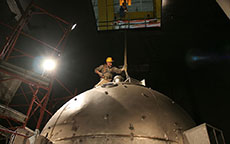Dark-matter seekers get help from the DarkSide
 |
This dramatic shot shows the final stages of assembly of the 4-meter-diameter steel vessel, which will house the liquid scintillator and the low-radioactivity liquid-argon detector. Photo: Yuri Suvarov, UCLA
|
A treasure trove of dark-matter detectors rests within the deep reaches of Italy's Apennine Mountains as part of the Gran Sasso National Laboratory. The mountains shield them from cosmic rays, making these detectors highly sensitive to dark-matter particles.
Pushing the envelope for still higher sensitivity is the trove's newest jewel, the DarkSide-50 experiment, which is nearing the end of its construction. DS-50 will use 150 kilograms of low-radioactivity liquid argon, which Fermilab is helping to obtain, as target material for highly sought-after dark-matter candidates called weakly interacting massive particles, or WIMPs.
The mountains can't protect against all types of background contamination, one being radioactive decay from the materials of the apparatus – a major concern for dark-matter detectors like DS-50.
When a WIMP interacts with an argon nucleus, the nucleus will deposit the energy it is given in the argon, producing a flash of light and ionizing some of the argon atoms around it.
"Radioactive decays can mimic a WIMP because they deposit energy in the liquid that is close to the energy of interest," said Fermilab scientist Stephen Pordes, who works on the experiment.
In addition to using low-radioactive target material, the cryostat that will house the detector is made of low-radioactivity steel. Also, the air in the room where scientists are currently assembling the detector is free of radon, a radioactive element usually present in air that can stick to the materials.
DS-50 will be the world's first detector to use low-radioactivity liquid argon. Moreover, scientists are designing it to have some of the lowest rates of background events compared to similar detectors.
"The strategy we're following is to reduce the number of background events to less than 0.1 in three years," said Luca Grandi, a research associate at Princeton University. "That way, if we do get a bunch of events in the detector, it's a good bet that it will be WIMPs."
Next door to DS-50 is the ICARUS experiment, which includes the world's largest liquid-argon chamber used for detecting neutrino oscillations. The ICARUS detector holds 600 tons of liquid argon but, even if scientists were tempted to borrow some for DS-50, it would be of little use.
Read more
—Jessica Orwig
|